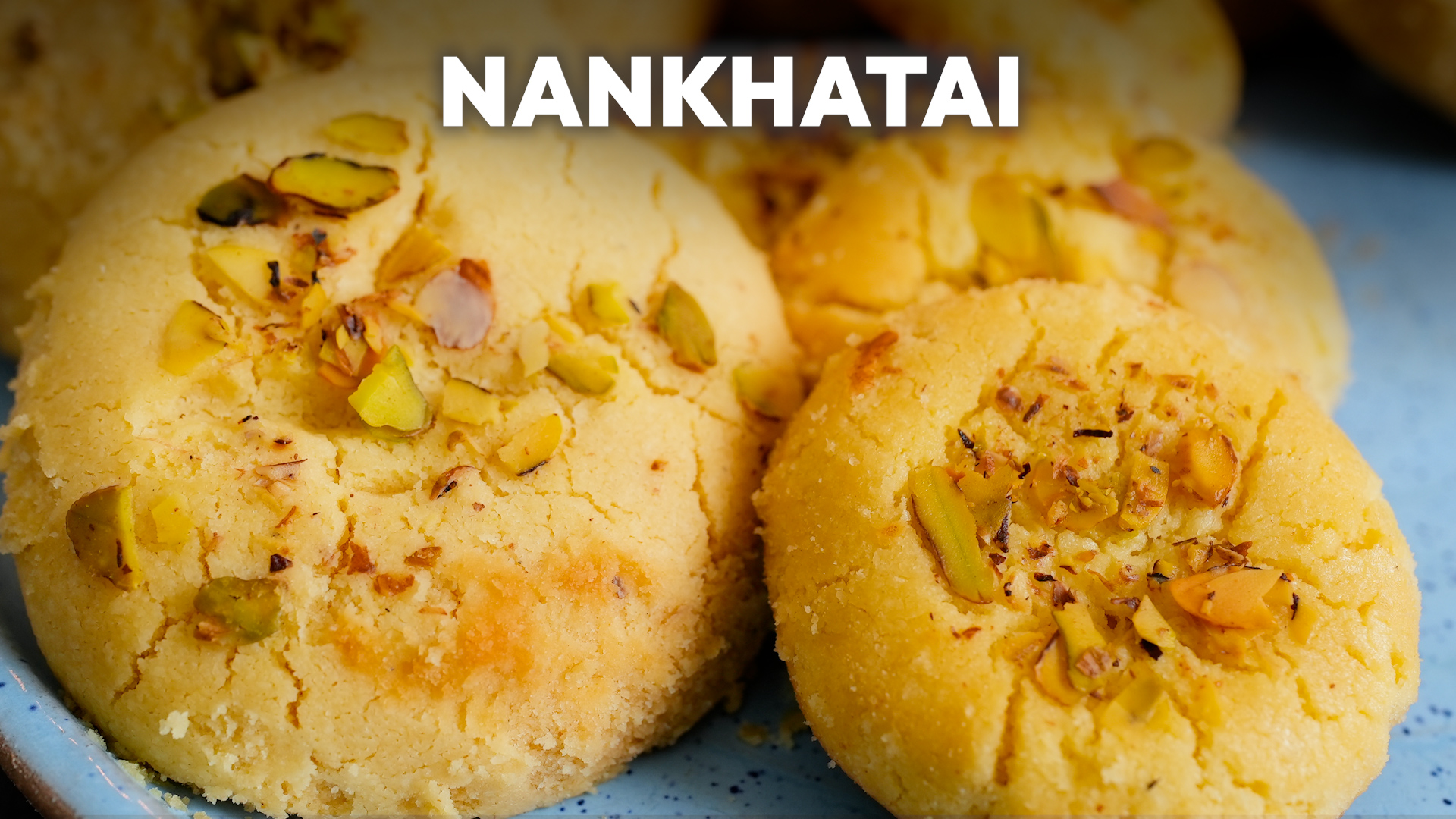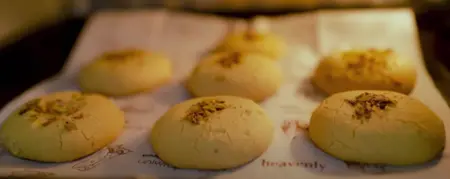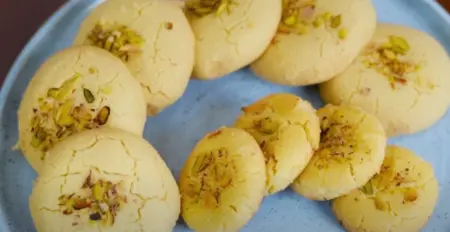
Nankhatai Recipe

15 Mins

6-7 People

10 Mins
Introduction
Let me take you on a journey back to my childhood kitchen, where the air was always filled with the aroma of freshly baked goodies. Among the array of sweets and treats, nankhatai held a special place in my heart. I remember eagerly waiting for my grandmother to pull out a batch of these delicate, melt-in-your-mouth cookies from the oven. The first bite was pure bliss - a perfect balance of buttery goodness and subtle sweetness. Since then, nankhatai has been more than just a cookie to me; it's a nostalgic reminder of cherished moments spent with loved ones.
Ingredients:
- Refined flour: 150 gms
- Besan (Gram flour): 45 gms
- Powdered sugar: 105 gms
- Ghee: 150 gms
- Cardamom: 3-4 pods (crushed)
- Baking powder: a pinch
- Chopped pistachios: for garnish
Instructions:
Step 1: Preparation
Gather all the dry ingredients—refined flour, besan, baking powder, powdered sugar, and cardamom powder. Sieve them into a large mixing bowl to ensure a smooth texture.
Step 2: Kneading the Dough
Make a well in the center of the dry mixture and add ghee. Using your hands, gently knead the ingredients until they form a soft dough. The ghee enhances the flavor of the biscuits.
Step 3: Resting the Dough
Transfer the dough to a bowl and cover it with cling wrap. Let it rest in the refrigerator for about 10 minutes to firm up slightly.
Step 4: Preparing the Setup (Stovetop)
Heat a pressure cooker without the gasket and whistle. Place a small mold or stand inside the cooker to elevate the plate for the biscuits.
Step 5: Shaping the Nankhatai
Divide the chilled dough into small, uniform portions, typically 40-50 grams each. Roll them into smooth, round shapes and place them on a plate. Sprinkle chopped pistachios on top and gently press them in.
Step 6: Baking (Stovetop)
Carefully place the plate with the dough balls inside the preheated pressure cooker, over the mold. Close the lid and bake for about 8-10 minutes over a low flame until golden brown.
Step 7: Cooling (Stovetop)
Once baked, remove the plate from the cooker and allow the nankhatai to cool slightly before transferring them to a serving plate.
Step 8: Baking (Oven)
If using an oven, preheat it to 180°C. Line a baking tray with parchment paper and place the dough balls on the tray. Add chopped pistachios and bake for 13-15 minutes until golden brown.

Step 9: Cooling (Oven)
Remove the tray from the oven and let the nankhatai cool down to room temperature.

Step 10: Serving
Serve the freshly baked nankhatai alongside a hot cup of tea for a delightful treat. They also make for a perfect gift to share the joy of homemade goodness with loved ones.

About the Recipe
Nankhatai is a traditional Indian shortbread cookie that traces its roots back to the Persian-influenced cuisine of the Mughal era. It is made with simple ingredients like flour, sugar, ghee (clarified butter), and flavored with cardamom or nutmeg. The word "nankhatai" is derived from Persian, where "nan" means bread and "khatai" refers to a biscuit. These delightful treats are often enjoyed during festivals, celebrations, or as an indulgent snack with a cup of chai (tea).
Cooking Tips
1. Proper Mixing
Ensure that the dough is well mixed but not overworked. Overmixing can lead to tough cookies. Mix until the ingredients are just combined and the dough comes together.
2. Chilling the Dough
Chilling the dough before shaping and baking helps the cookies retain their shape and prevents them from spreading too much during baking. Aim for at least 30 minutes of chilling time in the refrigerator.
3. Evenly Sized Cookies
For uniform baking, divide the dough into equal portions and roll them into smooth balls. This ensures that all the cookies bake evenly and have a consistent texture.
Pairing Guide
Nankhatai pairs beautifully with a variety of beverages, making it a versatile treat for any occasion. Enjoy it with a steaming cup of masala chai for a classic combination of flavors. For a modern twist, pair it with a creamy latte or a fragrant cup of herbal tea. Nankhatai also complements fruity flavours, so consider serving it alongside a refreshing glass of mango lassi or strawberry milkshake.
Frequently Asked Questions about Nankhatai
-
What is nankhatai? Nankhatai is a traditional Indian shortbread cookie made with flour, sugar, ghee (clarified butter), and flavored with cardamom or nutmeg.
-
What does nankhatai mean? The word "nankhatai" is derived from Persian, where "nan" means bread and "khatai" refers to a biscuit or cookie.
-
Can I make nankhatai without ghee? While traditional nankhatai recipes use ghee for its rich flavor, you can substitute it with an equal amount of unsalted butter for a similar result.
-
How long do nankhatai cookies stay fresh? Nankhatai cookies can be stored in an airtight container at room temperature for up to 1-2 weeks. They may become slightly softer over time but will still be delicious.
-
Can I freeze nankhatai dough? Yes, you can freeze nankhatai dough for later use. Wrap the dough tightly in plastic wrap or parchment paper and place it in a freezer-safe bag or container. Thaw it in the refrigerator before baking.
-
Can I add nuts or dried fruits to nankhatai? Yes, you can customize nankhatai by adding chopped nuts such as almonds, pistachios, or cashews, as well as dried fruits like raisins or chopped apricots for extra flavor and texture.
-
What is the best way to enjoy nankhatai? Nankhatai is best enjoyed as a snack with a hot cup of tea or coffee. It also makes a delightful addition to festive platters or as a homemade gift for loved ones.
-
Can I make nankhatai gluten-free? Yes, you can make gluten-free nankhatai by using a gluten-free flour blend in place of regular flour. Ensure that all other ingredients are also gluten-free.
-
How do I achieve a crumbly texture in nankhatai? To achieve a crumbly texture in nankhatai, avoid overmixing the dough and handle it gently while shaping the cookies. This helps create layers in the dough, resulting in a melt-in-your-mouth texture.
-
Is nankhatai suitable for vegans? Traditional nankhatai recipes use ghee, which is clarified butter and therefore not vegan. However, you can experiment with vegan butter or coconut oil as substitutes for a vegan-friendly version of nankhatai.
